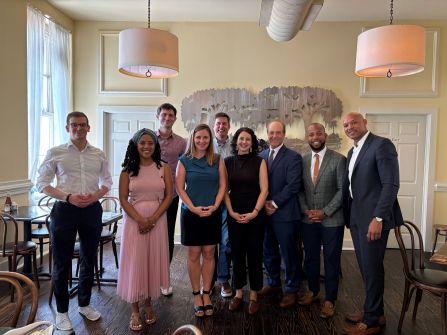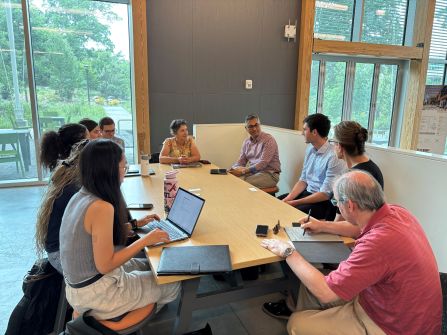
The Clean Economy Bridge (TCB) expert visits to South Carolina and Georgia, led by TCB Lead Mary Hellmich (adelphi) and joined by German experts Dr. Tim Mandel (Fraunhofer Institut) and Lorenz Kahle (dena), offered a unique window into the Southeast’s evolving clean energy landscape. The region is experiencing rapid growth in clean energy sectors while navigating the challenges common to many jurisdictions embarking on rapid decarbonization around regulation, public acceptance, and grid resilience. Across both states, several institutions and meetings with institutions and stakeholders stand out as opportunities for deeper US-German cooperation.
South Carolina: Key Topics and Institutional Partners
South Carolina is emerging as an energy innovation hub, recently recognized as a national “tech hub” under the CHIPS and Science Act. At the heart of this transformation is SC Nexus for Advanced Resilient Energy (SC NEXUS), a coalition of public and private partners - including many German companies - dedicated to advancing, testing, and deploying new energy. SC NEXUS’s collaborative approach, leveraging “tech beds” across the state, exemplifies the kind of model that can accelerate the clean energy transition.
During the study tour, TCB Lead Mary Hellmich and the German delegation met with a broad spectrum of South Carolina’s clean energy stakeholders. These included policymakers (see below), government and agency leaders (SC Department of Commerce, SC NEXUS, the SC Energy Office, and the National Association of State Energy Officials) academic and research experts from the University of South Carolina, industry representatives from Duke Energy, Santee Cooper and Phenogy, as well as civil society leaders (e.g. Southern Alliance for Clean Energy).
Energy is becoming an increasingly pressing issue in South Carolina, as highlighted by the recent passage of the.newly enacted Energy Security Act, which establishes a framework for the competitive procurement of renewable energy and co-located energy storage, directs the Public Service Commission (PSC) to consider updates to voluntary renewable energy programs, and gives the state’s utilities more flexibility to offer competitive rates to attract businesses. In this context, stakeholders were especially interested in Germany’s achievements in grid stability with high shares of renewables, which is seen as a success story that can help to address local concerns and build momentum for South Carolina’s clean economy future.
During a working lunch, South Carolina state senators and representatives - including Senator Deon Tedder, Senator Ed Sutton, and Representatives Courtney Waters, Tom Hartnett, and Spencer Wetmore - shared candid reflections on the state’s clean energy landscape. They openly acknowledged several persistent challenges, including regulatory and legislative gaps, the lack of statutory emission-reduction targets, and the limited resources of the Public Service Commission (PSC), which currently depends heavily on utility-supplied data for major decisions. Legislators described the economic barriers to distributed solar and the absence of a comprehensive transmission roadmap, while also noting the legislative-regulatory disconnect that restricts direct policy action on renewables. Despite these hurdles, they recognized the recent SC Energy Security Act as a promising step forward, introducing a competitive procurement process for renewable energy and energy storage, and creating new mechanisms to hold utilities accountable for meeting state energy goals. Importantly, the legislators expressed strong interest in learning from Germany’s experience, particularly in building public acceptance for renewables and advancing grid stability.
USC, through its Carolina Advanced Electricity Institute, is at the forefront of intelligent grid research, AI-driven grid management, and system stability with high shares of renewables. Professors at USC are eager to engage with German peers on battery integration, digital twins for grid operations, and advanced grid resilience. South Carolina’s utilities, particularly Santee Cooper and Duke Energy, are open to technical exchanges on demand-side management (DSM) and hydrogen applications. Santee Cooper’s DSM program, which allows for rapid load control, is a best practice that German utilities could adapt. There is also strong interest in Germany’s expertise on community acceptance strategies for renewables.

Georgia: Key Topics and Institutional Partners
The TCB tour continued for three more days in Georgia to facilitate bilateral meetings and discussion rounds with a broad range of stakeholders and institutions, including the North American Electric Reliability Corporation (NERC), Georgia Institute of Technology, the Southeast Energy Efficiency Alliance (SEEA), the Georgia Public Service Commission, Georgia Power, and local academic and community leaders. This comprehensive engagement provided valuable insights into Georgia’s rapidly expanding clean energy sector, particularly in solar, electric vehicle manufacturing, and business investment.
The NERC, headquartered in Atlanta, plays a central role in ensuring grid reliability across North America. NERC’s work on reliability standards, DSM, and adapting to the surge in data center electricity demand mirrors many German priorities, yet challenges remain due to fragmented planning and the scale of future demand. This makes NERC a valuable partner for bilateral exchange, particularly as both the US and Germany face similar questions around resource adequacy and market design.
Georgia Institute of Technology (Georgia Tech) stands out for its leadership in bridging technical innovation with community engagement and environmental justice. The Kendeda Building for Innovative Sustainable Design, located on Georgia Tech’s campus, serves as Georgia’s first “living building” and a flagship for sustainable construction and interdisciplinary research. Georgia Tech’s stakeholder-driven projects, such as direct air capture (DAC), demonstrate how public trust can be built for advanced clean technologies. The Southeast Energy Efficiency Alliance (SEEA) and the Georgia Public Service Commission (PSC) further shape the state’s energy landscape, balancing reliability, affordability, and innovation.
Georgia Power’s evolving grid management, especially around data centers and demand-side management, offers practical insights for German partners. Adjustments to the Integrated Resource Plan (IRP) in response to regulatory and market pressures, and considerations for new grid codes for data center stability reflect a pragmatic approach to emerging challenges. Bilateral meetings on market design, grid codes, and master planning, drawing on Germany’s “Netzentwicklungsplan / Network Development Plan Electricity” and regulatory frameworks, are promising next steps for knowledge sharing and collaboration.
Takeaways and next steps
The TCB values immensely the insightful discussions with the participation institutions in South Carolina and Georgia and will continue to deepen these partnerships for its future work, especially in the areas of grid stability, renewables integration, and equitable clean energy adoption. Germany and the US Southeast would benefit from continued collaboration on the topics of DSM, hydrogen, and grid resilience, with a strong focus on sharing evidence-based success stories from both sides. The evolving role of the “One Big Beautiful Bill” Act highlights the increasing importance of strengthened subnational and bilateral partnerships and networks, as state-level support incentives for renewables for clean energy can be subject to changing policy landscapes. The TCB will connect the dots to help ensure that innovative solutions, best practices and investments flows can continue to support accelerating the clean economy transition in Germany and the Southeast.
